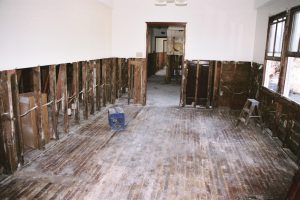
When a natural disaster strikes, as they often have this year, the damage is usually quantified in dollars. Those dollars represent the cost of rebuilding (the fiscal cost) which is a direct connection between the disaster itself and the construction industry which will power the recovery.
While there is so much more than rebuilding to worry about in the aftermath of disaster, construction can’t be overlooked. And while it often takes months or years to feel whole again, the calming effect of getting the house or the business back to normal cannot be understated.
Since 2017 has been an unprecedented year in terms of natural disasters – both in frequency and in scope – we thought we’d take another look at the construction industry’s role during a recovery.
2017 Was An Unprecedented Year
According to the National Oceanic and Atmospheric Administration (NOAA), there were “16 weather and climate disaster events with losses exceeding $1 billion each across the United States,” with total damages nationwide exceeding $300 billion.
Of course, almost all of that $300 billion figure will go towards construction costs. That’s a huge amount of money that has the power to transform the dynamics of an entire industry, let alone the affected regions of the country.
We’ve Been Through It Ourselves
In New Orleans, we are all too familiar with the song and dance of hurricane season. Personally, the memories of putting our house and my mom’s business back together after Hurricane Rita back in 2005will forever be etched into my brain. But what’s more – Levelset was actually spawned from our CEO Scott Wolfe’s experiences in the wake of Hurricane Katrina. Construction payment problems persist every day, but following a natural disaster, they’re amplified. Our goal is to bring fairness to construction payment, and that could never be more important than in the aftermath of a natural disaster.
Disaster Recovery and Construction Go Hand In Hand
Earlier this year, we put together the Playbook for Disaster Recovery to provide perspectives and information for both sides of the table. The goal of the playbook is twofold: first, it provides tips for property owners to protect themselves during the rebuilding process as well as tips for contractors, suppliers, and others who are performing the recovery work.
A Few Important Things to Keep in Mind
Construction payment laws vary greatly from state to state
Often when a disaster strikes, the rebuilding effort requires many more construction resources than are available from the affected area. (Additionally, the local construction workforce is going to be affected by the disaster too. They may not be able to participate in the recovery even if they want to.) This means that recovery work will often attract contractors, suppliers, and other industry participants from out-of-state. While this is generally a good thing, these companies need to understand that construction payments in the affected state may not work the same way that they do at home.
Here are a few more articles that are important reading for companies involved in recovery work:
- Recovering From Hurricane Irma
- What Out-of-State Contractors Heading to Texas to Help Post-Harvey Need to Know
- Recovering from the California Wildfires: What Contractors Need to Know
- The Payment Perils of Property Restoration Companies
Disasters Attract Unscrupulous Actors
It’s a truly unfortunate fact of the industry that some see natural disasters such as an opportunity to pull one over on unsuspecting property owners. But it’s still a fact. We’ve covered post flood contractor fraud in Baton Rouge, a corrupt contractor working in disaster preparedness in New Orleans, and Florida contractors scamming homeowners.
Because of situations like these, a significant chunk of the Playbook for Disaster Recovery is devoted to protecting homeowners from unscrupulous contractors. Rebuilding is hard enough – insurance rarely covers everything and funds will be limited. Issues like these can be demoralizing when resilience is paramount.
Disasters Also Attract the Best People on the Planet
Disasters devastate communities, put homeowners and businesses in unenviable hardship, and can create a mess for those in the construction industry. But there are bright spots, too. At the end of the recent disaster posts, we’ve tried to make it a habit to end on a high note- and we’ll do that here! In California, there were stories about a contractor building tiny homes for those left homeless by wildfires. In Baton Rouge, the Cajun Navy risked their lives to save those trapped by the flood. After Harvey this story about Baby Hope popped up (special shoutout to my mom getting name-dropped in this article).
Extreme acts of kindness, heroism, and generosity can be found after virtually every catastrophic weather event. Those stories above, and the countless others, help to take the edge off the realities of these situations.
Conclusion
Overall, the construction industry is so vital to the economy and to the entire country as a whole. We don’t want to pick favorites or to in any way suggest that one aspect of construction is somehow more important than another. But that being said, there is something truly special about the folks that go to work helping to rebuild the communities, towns, and regions that have been hit by natural disasters.
We also want to help make sure that all of those hard-working folks get paid the money they earn as they do their part in the recovery. We’ve put together a free resource that will help you do just that. Click here to download our Disaster Recovery Cheat Sheet to give you a leg up on protecting the payments you earn doing recovery work.

